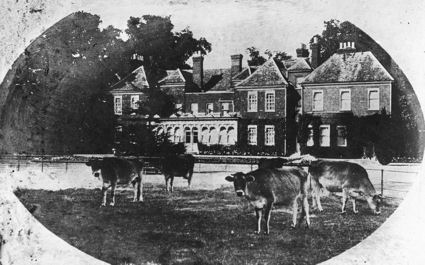Following his appointment as Head Teacher of the Church School in 1908, Percy Robinson built up an extensive knowledge of Trumpington’s history. One of his individual notes from the 1920s is about Trumpington and the Domesday Book and manors, reproduced below.

The earliest account of Trumpington, from the “Inquisition of the County of Cambridge” about A.D. 1080. (Domesday Book)
British Museum Maunuscript, Tiberius A.6. leaf. 85
The sixth line begins: In hoc hundred trumpintona pro . . “In this hundred Trumpington was assessed at 12 hides and is so now. Of those 12 hides William de Callei (Cayley) holds 4½ hides of William de Warenna (i.e. the Earl of Garenne in France). The arable land there is five ploughs (?600 acres); two ploughs in the domain and three ploughs for the villagers. There are nine villagers, four cottagers, two servants, one mill worth 20s., meadow for five ploughs (40 oxen), pasture for the town herd; and 4 plough shares; ten idle animals (riding horses), 84 sheep, 44 pigs. Altogether it is valued at £6; when it was received at £6; in the time of King Edward at £7. This land was held by Tochill of the Church of St. Awdry of Ely in the time of King Edward and at his death, on condition that he was not allowed to give or sell it to anyone, nor to separate it from the Church without the leave of the monks. This land was part of the “honour” of Frederick brother of William de Warenna.” This was Cayley’s manor. Similar details are given of the other manors.
2. Hervey holds 2 hides 45 acres of Picot the sheriff, valued at £4.
3. Arnold de Aerda holds 2 hides 15 acres of Earl Eustace, valued at £4. (Arnold’s manor).
4. Robert son of Fafiton holds 2 hides of the King, valued at £5.
5. Godlam holds half a hide of the Countess Judith, Valued at 10s.
6. A townsman of Cambridge holds 30 acres, for which he pays taxes in Cambridge.
Note: A hide of land has not been definitely ascertained but has been differently estimated at 80, 100, and 120 acres.
From the foregoing it is noted that there were six manors, but it is also recorded that there was another that belonged to the convent of Ely and was given to them, by Duke Brithnoth in 991. Of this nothing much is known, and no mention is made of when it was alienated from the monastery.
An account of the manors is as follows:-
1 . The manor of Caleys or Trumpington De la Pole, to which the advowson of the church belonged, was the chief manor in this parish and was held under the Earl of Winchester in 1237 by the Caleys, and passed through the families of Harrington, De la Pole, Ingoldsthorp, Neville, Scrope, Browne, Cutts , Chaplin, Bacchus, and Baron, who purchased it in 1616. In 1775 Mr. Crabtree who married the niece of the Baron family sold the estate to the father of F.C.J. Pemberton, Esq.
2. A manor belonged for close on two centuries to the family of Trumpington and passed by female heirs to the Enderbys and Pigotts. This was sold in 1547 to Edward Pychard. In 1675 Sir Francis Pemberton, afterwards Lord Chief Justice, purchased it.
In 1314 Giles de Trumpington had a grant of a fair to be held within this manor for three days at the festival of St. Peter, and the village feast, what is left of it, is still held on this festival.
3. Arnold’s manor took its name from the family of Arnold, who held it under the Valences. It passed through the families of Porter, Francis, and Charlton, but was forfeited by the latter and given to John Fortescue, who died in 1518. This manor became by purchase the property of Dr. Eden, master of Trinity Hall, who died in 1645. It was afterwards purchased by Francis Pemberton and is now in the possession of this family.
4. The manor of Beaufoes, later Crocheman’s, was sold to the latter family in 1331. It passed to the Bowyer family but was escheated to the crown for a debt. Afterwards it was granted to Hansard and others who sold it to Edward Bacchus, Esq. Mr. Bacchus rebuilt the manor-house, and his grandson sold it to James Thompson, Esq. This was the estate of the late Christopher Anstey, author of the poem, The Bath Guide, who inherited it from the Thompsons. This in now the property of George R.C. Foster, Esq. J.P.
5. The manor of Tincots was so called from the family that held it. By successive purchases it passed to the Pychards and Thompsons and was inherited with the manor of Crochemans by Mr. Anstey.
A manor was said to belong to the nuns of St. Radegund and afterwards to the master and fellows of Jesus College. The college has an estate of about thirty acres of land in Trumpington.
The manors 1,2, and 3, Caleys, Picots, and Arnolds, form part of the Pemberton Estate, whilst 4 and 5, Beaufoes and Tincots, belong to G.R.C. Foster, Esq., J.P. No.6, Radegund, probably is the land held by the master and fellows of Jesus College, who hold an estate of about thirty acres in Trumpington.
Scanned from Percy Robinson’s original typescript by Howard Slatter.